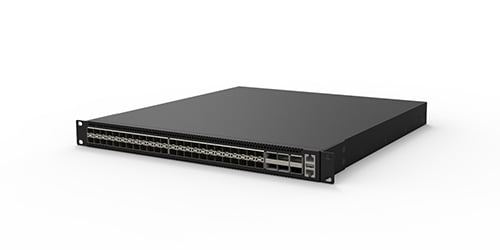CX206P-48S-M-H
48x10Gb SFP+, 6x100Gb QSFP28 L3 Leaf & Core Switch, Enterprise SONiC Ready
- 48 -Port 10Gb SFP+ with 100Gb QSFP28 uplinks Core Switch
- Core /Leaf(TOR)switch for enterprise networks and data center
- Support MLAG,VXLAN, QoS,BFD,IPSG,IPV6,etc
- A feature rich SONiC NOS installed
Specifications
|
Connectivity Solutions
Features
Layer2/layer3 Features
- VLAN, MAC dynamic learning, MAC flapping detection, LLDP
- Voice VLAN, QinQ, STP, MSTP, Port mirroring based on RX and TX direction, Storm suppression, IPv4, IPv6 dual stack, Static ARP, Dynamic ARP,ARP Proxy, DHCPv4, v6, DHCP relay, NDP, Switch Virtual Interface (SVI)
- Routing protocols: OSPFv2, OSPFv3, BGP4, BGP4+, ISIS
- Policy routing based on 5-tuple, Equal Cost Multi Path (ECMP), IGMPv1, IGMPv2
- Multicast VLAN,VRF,VXLAN,EVPN,EVPN VXLAN,GRE
Comprehensive Network Security
- TACACS+802.1x and MAB authentication
- Security features
- Ingress and egress AC
- Layer 2 port isolation
- DHCPv4, v6 Snooping.
- ND Snooping
- Dynamic ARP Inspection (DAI), IP Source Guard v4, v6.
High Reliability and Rich QOS
- Priority mapping based on 802.1p and DSCP, Traffic policing, Traffic shaping based on port or queue, Quality of Service, Queue scheduling based on PQ and DWRR algorithms, Static link aggregation, LACP, MCLAG,Load balancing based on SMAC.
- DMAC, SIP, DIP, SPORT, DPORT and other HASH methods
- Uplink and downlink association (monitor-link)
- BFD: OSPF, BGP, IS-IS association.
Easy Network Maintenance
- SSH, telnet, console login, CLI style: Linux, Klish
- SNMPv1, SNMPv2, SNMPv3
- Zero Touch Provisioning (ZTP)
- Precision Time Protocol
- Network Time Protocol (NTP)
- Syslog, Management.
- Alarm information: temperature, power, fan, traffic LACPc overflow.
Enterprise SONiC 48 Ports SFP+ Core Switches with PTP Support(Optional)
Currently, the CX206P-48S-M-H offers support for the IEEE1588 PTPv2 standard and SMPTE 2059-2 profile through both hardware and software. The hardware port offers full support for PTP and can be used as a boundary clock(BC) or Transparent clock (TC). The module can be flexibly disassembled based on customer requirements. On the software side, Asterfusion leads the community in implementing the PTP function in SONiC and optimizing its performance on our Enterprise SONiC Distribution –AsterNOS. By utilizing hardware acceleration and software algorithm optimization, the PTP protocol achieves a synchronization deviation of 20ns, significantly enhancing speed and stability in protocol interaction. Additionally, interoperability is greatly improved as it supports configurations such as restAPI, RestConf, Netconf, and CLI.

What’s in the box
- RJ45 Console Cable
- Preloaded Enterprise SONiC Distribution-AsterNOS
- 1RU Switch
Resources
Warranty
This model is backed by a 2 year limited hardware warranty. Multiple extended support options, including advanced replacement and 24×7 support services, are available. Contact us for complete details.
Warranty
This model is backed by a 2 year limited hardware warranty. Multiple extended support options, including advanced replacement and 24×7 support services, are available. Contact us for complete details.
FAQ
What are the feature that your SONiC support?
It built on top of standard Linux systems and with SONiC/SAI as its kernel is characterized by fully open structure, completely decoupled hardware and software, loosely unionized software modules, high reliability architecture, and easy functional expansion. It leverages the latest technologies such as containers and in-memory database.
Does AsterNOS can run on other vendor’s hardware?
Our SONiC based AsterNOS can perfect run on our own hardware, in theory it can run on other vendor’s Tofino based hardware, there wil be a problem on verifng the compatibility between our software and other vedor’s hardware,we can arrange a meeting call discuss specically. I strongly suggest you to use our own hardware, which supports the best software compatibility, tech support, hardware stability and of course very good cost.
Is there any license fee or software support fee that we need to pay for your version of SONiC?
Usually our AsterNOS runs on our own hardware (for Tofino and Teralynx), we provide either bare metal hardware, or hardware with AsterNOS, there is some amount of software cost if you choose H/W and S/W bundle, but this bundle should be more cost effective than today’s WhiteBox from one vendor and NOS from another vendor.
Does AsterNOS Suport Intel,Broadcom?
Our AsterNOS software support intel ,not Broadcom.
What is the difference SONiC and P4, and also tell us the difference of your NOS and those similar.
SONiC is used in most data center fabric as the basic OS, our software work on both innovium and marvell makes SONiC be able to run these switch chips smoothly, which is our value to help people who want to use innovated features on today’s new switch chip other than broadcom.
P4 is another approach for today’s network disaggregation, it has pretty good usability in niche markets like gateway, load balance or NPB, in these market when people also want to be part of cloud eco system, they need a way to combine P4 with SONiC, that’s what we are doing, we help people to implement these applications in SONiC way.
Is it easy for us to change and use the functions (Software) provided by Asterfusion, or to add functions related to the packet control and management function (OAM)?
It depends on your application, in general you can easily start from either SDE or SONiC to all the functions about date plane and management plane.
What is the scope of the software source code that can be distributed and the source code that cannot be provided?
SONiC community source code and our patch are available as source code.


